On this page:
Introduction
The Child Care in Australia quarterly information report presents data for the September quarter 2020 and provides information on child care usage, services, fees and subsidies in Australia including for states and territories.
The Child Care in Australia publication includes a five quarter timeseries for many of the key measures. However, due to the temporary measures implemented as part of the Australian Government’s ECEC COVID-19 relief package, data for June quarter 2020 is not available.
The September quarter 2020 is also impacted by these measures, with two weeks of data aligning to the September quarter not being available. For this reason, there are 11 weeks of data in the September quarter, rather than the typical 13 weeks. This, along with second wave COVID-19 lockdowns, particularly in Victoria, and an apparent adjustment to the behaviour of families using child care, particularly Outside School Hours Care, has affected the findings in the September quarter.
Australian Government Response to Covid-19.
The Australian Government allocated nearly $3 billion to support early childhood education and care services during Covid-19. This kept the sector viable and ensured care was available for essential workers and families with vulnerable children.
Key Highlights
Overall, 1,216,770 children and 886,400 families attended a Child Care Subsidy approved child care centre in the September quarter 2020. Of these, 1,178,370 children and 850,870 families had their eligibility for Child Care Subsidy assessed.
The remainder of the Child Care in Australia analysis considers only those children who were eligible for the CCS.
In the September quarter 2020, 42.6 per cent of children aged 0-5 years and 28.6 per cent of children aged 0‑12 years used approved child care.
Average weekly hours per child across all service types was 25.8 hours. For Centre Based Day Care the average was 30.7 hours per child, or approximately three days per week.
Total subsidy (Child Care Subsidy and Additional Child Care Subsidy) was $1.84 billion for the September quarter 2020.
The average hourly fee across all care types (excluding In Home care) was $10.20, reflecting an increase of 2.6 per cent since the September quarter 2019.
Child Care Usage
Children
During the September quarter 2020, there were 1,178,370 children who attended approved child care and were eligible for Child Care Subsidy. This represents an annual decrease of 12.1 per cent (or 162,050 children) since the September quarter 2019. The number of children attending Outside School Hours Care decreased significantly by 23.8 per cent from 481,630 children to 367,100 children over the year to the September quarter 2020. These shifts are largely due to impacts of COVID-19 on the child care sector, with the largest decline in Victoria.
By service type, 63.5 per cent of children in child care attended Centre Based Day Care (747,130), followed by Outside School Hours Care with 31.2 per cent (367,100 children) and Family Day Care with 7.4 per cent (87,050 children). (Note: In Home Care has been excluded from all service type, state and usage analysis due to privacy considerations.)
By state, New South Wales had the largest share of children attending approved child care (33.7 per cent or 397,130 children).
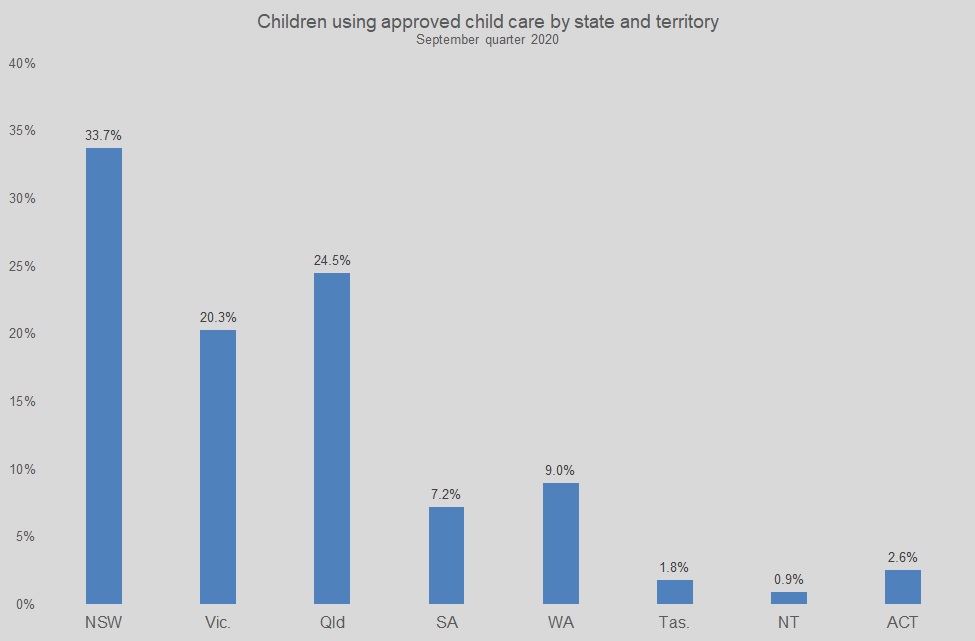
Note: In Home Care has been excluded from these percentage calculations due to privacy considerations.
Note: This quarter's data may have been impacted by behaviour change associated with the impacts of COVID-19.
There were 38,130 children accessing Additional Child Care Subsidy in the September quarter 2020.
Indigenous children
During the September quarter 2020, 45,670 Indigenous children attended approved child care and were eligible for Child Care Subsidy, down 2.4 per cent from the September quarter 2019.
By state, New South Wales had the largest share of Indigenous children attending approved child care (36.7 per cent), followed by Queensland (34.4 per cent) and Western Australia (7.9 per cent). (Note: In Home Care has been excluded from all service type, state and usage analysis due to privacy considerations.)
In addition, a significant proportion of Indigenous children attended Centre Based Day Care (71.5 per cent). This compares with 63.5 per cent for all children in child care. Approximately one quarter of all Indigenous children (23.8 per cent) attended Outside School Hours Care compared to 31.2 per cent of all children.
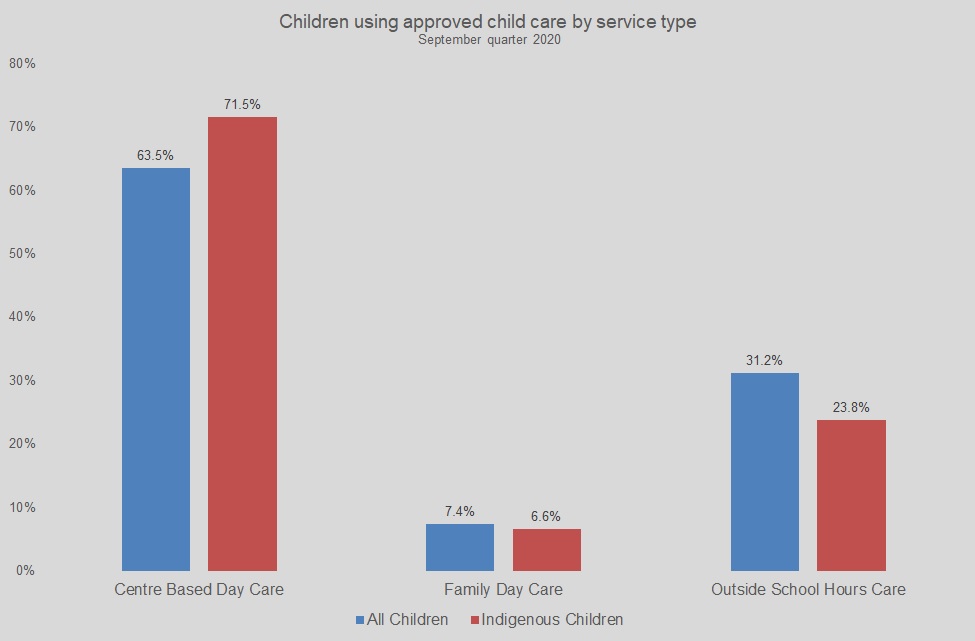
Note: This quarter's data may have been impacted by behaviour change associated with the impacts of COVID-19.
Families
During the September quarter 2020, there were 850,870 families who used approved child care and were eligible for Child Care Subsidy. This represents an annual decrease of 10.1 per cent (or 95,100 families). The number of families accessing Outside School Hours Care decreased by 23.4 per cent from 351,970 in the September quarter 2019 to 269,490 in the September quarter 2020. This again was largely due to impacts of COVID-19 on the child care sector, with the largest decline in Victoria.
In relation to families in Centre Based Day Care by state, New South Wales had the largest share of families with 288,960 families attending (34.0 per cent).
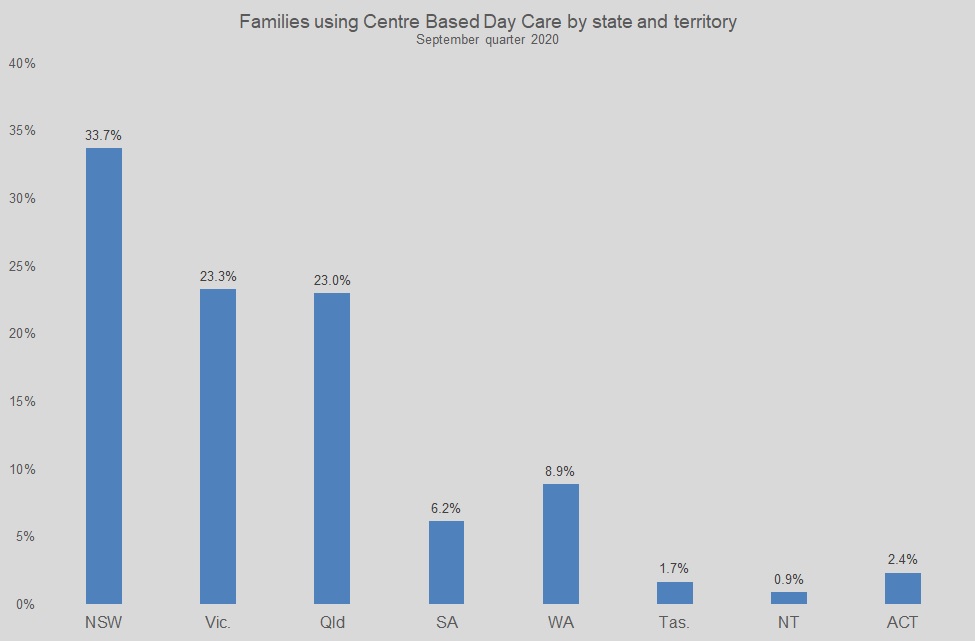
Note: This quarter's data may have been impacted by behaviour change associated with the impacts of COVID-19.
There were 26,870 families accessing Additional Child Care Subsidy in the September quarter 2020.
Average weekly hours
During the September quarter 2020, average weekly hours of child care use per child (excluding In Home Care) was 25.8 hours.
In relation to Centre Based Day Care by state, Northern Territory had the highest average weekly hours (36.7 hours) and Tasmania had the lowest average weekly hours (25.2 hours).
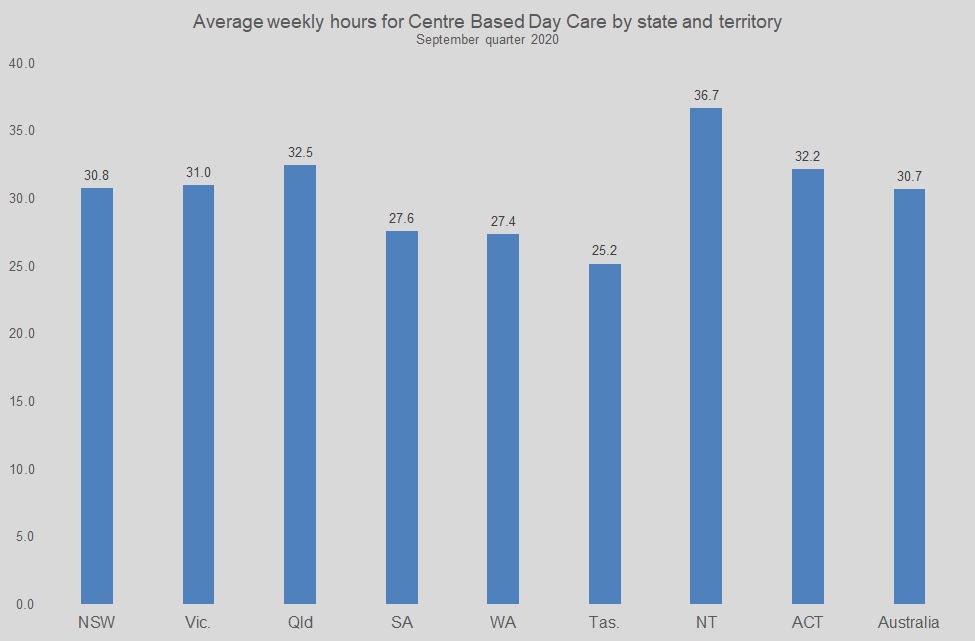
Note: This quarter's data may have been impacted by behaviour change associated with the impacts of COVID-19.
Services
Number of Services
During the September quarter 2020, 13,259 approved child care services operated in Australia. There were 8,304 Centre Based Day Care services (62.6 per cent of all services) and 4,476 Outside School Hours Care services (33.8 per cent). In annual terms the number of services grew in Centre Based Day Care (248 services or 3.1 per cent) but declined in Family Day Care (24 services or -5.2 per cent) and Outside School Hours Care (78 services or -1.7 per cent) compared to September quarter 2019.
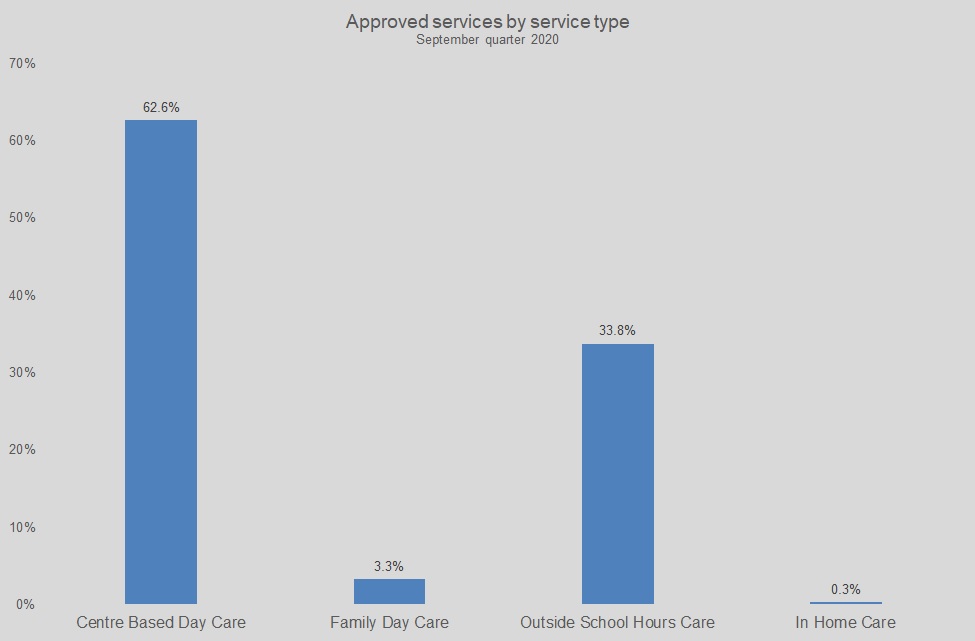
Note: This quarter's data may have been impacted by behaviour change associated with the impacts of COVID-19.
Fees
Costs of care before Australian Government fee assistance
During the September quarter 2020, the average hourly child care fee for all service types (excluding In Home Care) was $10.20, reflecting an increase of 2.6 per cent since the September quarter 2019.
Across care types, Outside School Hours Care had the lowest average hourly fee ($7.70 per hour) while Family Day Care had the highest ($10.60 per hour).
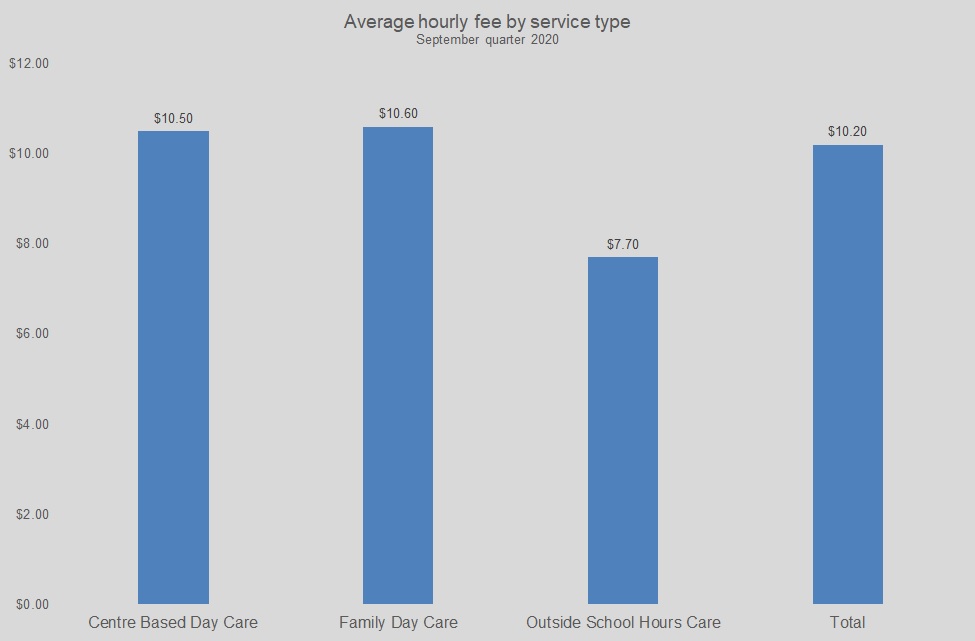
Note: In Home care has been excluded from the total average hourly fee calculation.
Note: This quarter's data may have been impacted by behaviour change associated with the impacts of COVID-19.
The hourly rate cap (children below school age) for Centre Based Day Care was $12.20. All states and territories had average hourly fees below the hourly rate cap for Centre Based Day Care.
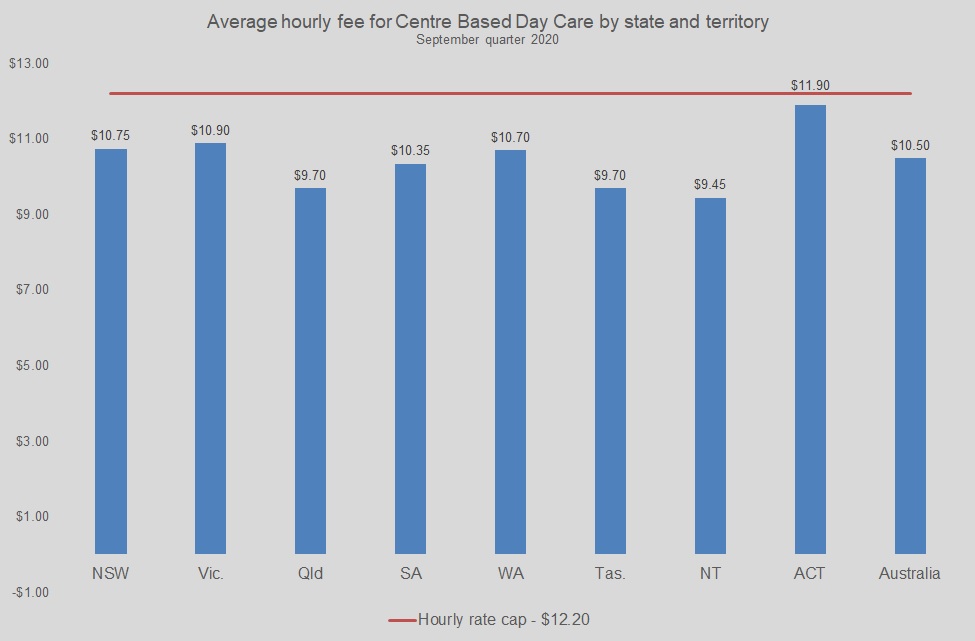
Note: This quarter's data may have been impacted by behaviour change associated with the impacts of COVID-19.
Data on Centre Based Day Care hourly fees by Statistical Area Level 3 (SA3) shows that the regions with the highest hourly fees are in parts of Sydney, Melbourne, Perth and Canberra. Fees in these areas have changed very little compared to the previous year. Generally, the highest rates of growth have been in areas with lower fees. Many of the regions with the high average fee growth were in regional Queensland and other parts of regional Australia.
Subsidies
Subsidies
The total estimated expenditure (Child Care Subsidy and Additional Child Care Subsidy) for the September quarter 2020 was $1.84 billion, down by 15.9 per cent since the September quarter 2019 ($2.18 billion).
The majority of Child Care Subsidy was paid in relation to families using Centre Based Day Care services ($1.54 billion or 83.6 per cent). Outside School Hours Care comprised 8.1 per cent of total subsidy in the September quarter 2020.
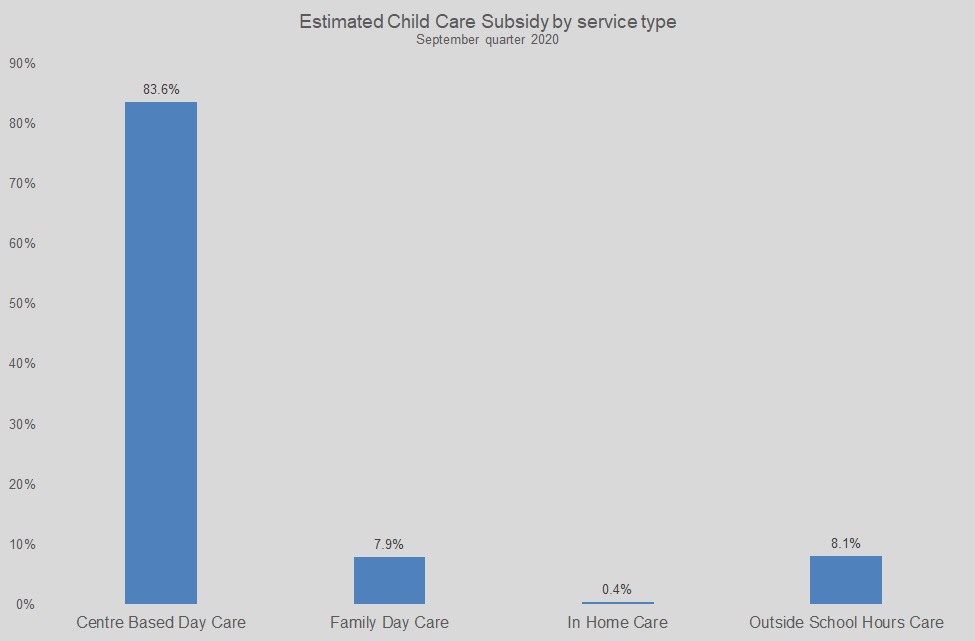
Note: This quarter's data may have been impacted by behaviour change associated with the impacts of COVID-19.
Additional Information
Downloads
Technical Notes
The introduction of the new child care package on 2 July 2018 changed major components of the child care system resulting in a break in series for some child care metrics. Points to note include:
- The population of children that are included in child care data reports from 2 July 2018 onwards covers those children who have been allocated a Customer Reference Number (CRN) by Centrelink.
- Changes to child care service approvals and service types has resulted in a reduced number of service approvals. For example, prior to 2 July 2018, a provider delivering vacation care, before school care and after school care would have been counted in child care data as three different services rather than the one Outside School Hours Care service as is the case from 2 July 2018 onwards. Accordingly, it is typically not possible to compare the number of services before and after the introduction of the new child care system.
- Prior to July 2018, approved child care types included Long day care (LDC), Family day care (FDC), In home care (IHC), Occasional care (OCC), Before school care (BSC), After school care (ASC) and Vacation care (VAC) (with BSC, ASC and VAC aggregated to form Outside School Hours Care). From 2 July 2018 onwards, approved child care types are Centre Based Day Care, Family Day Care, In Home Care and Outside School Hours Care. Only Family Day Care and In Home Care remain unchanged to compare service counts over time. Comparisons using pseudo service types may be undertaken to make broad comparisons (children, families, services) across the two child care systems by service type e.g. Combining LDC and OCC may provide a pseudo comparison group for Centre Based Long Day services in some instances with appropriate caveats.
- In Home Care subsidies became family based on 2 July 2018 and prior to this date they were child based. For this reason In Home Care is excluded from some tables in this report that are child based metrics (e.g. average hourly fee per child, average hours per week per child etc).
- Many services that were Budget Based Funded services prior to July 2018 have now been included in mainstream child care within Centre Based Day Care services.
- Due to the inclusion of many of the Budget Based Funded services into mainstream child care, the number of Indigenous children and families has increased compared to the counts under the previous child care system. In addition, changes have been made to the way Indigenous children and families are defined. Previously children associated with an Indigenous customer were counted as Indigenous, however, children are now also counted as Indigenous if the customer's partner is Indigenous. Similarly, Indigenous families are now counted when either the customer or the customer's partner is Indigenous. Previously, only customers who were Indigenous were counted as Indigenous families.
General counting rules
All analysis broken down by state in this report corresponds to the state of the service rather than the state where the child/family lives.
Use of child care services is counted for each individual child, who has been allocated a Customer Reference Number by the Department of Human Services (DHS), using approved child care services. An instance of child care usage is defined as at least one child care attendance per child care service for the quarter irrespective of duration or frequency. For example, a single hour at an In Home Care service or 40 hours per week throughout the quarter at a Centre Based Day Care, are both counted as an instance of child care usage.
Children and families are recorded for each of the service types that they use during the quarter. Children and families using more than one service type during the quarter or financial year are counted only once within each applicable service type category and only once within the 'Total' category for the relevant time period. Note that as children and families may use more than one service type in any particular timeframe the sum of the component parts may not equal the 'Total' category.
With the introduction of the new child care system, on 2 July 2018, counts of approved child care services reflect the number of services operating the four types of approved care; Centre Based Day Care; Family Day Care In Home Care; and Outside School Hours Care. A service is counted as 'active' only if it had at least one child attending at some time during the quarter, thus aligning the counting rules for children, families and services.
Child Care Subsidy estimation
The Child Care Subsidy (CCS) estimation method used in this report:
- CCS is likely to be under-estimated as only CCS payments made during the quarter are reported and not the amounts customers were actually entitled to but did not receive (for example because of families over-estimating income to avoid debts).
- Doesn't take into account reconciliation which will adjust the customers' CCS actual entitlements based on their actual rather than estimated incomes. There is a considerable time lag for the reconciliation process to be complete.
Data sources
Data included in this report comes from the following sources:
- The data is extracted from the Department of Human Services Enterprise Data Warehouse.
Revisions: Due to changes in the administrative system, data may be revised to ensure the most accurate, up-to-date figures are published.
Definitions
Additional Child Care Subsidy: A payment that provides targeted additional fee assistance to families and children facing barriers in accessing affordable child care.
Approved care: Care provided by Centre Based Day Care, Family Day Care, In Home Care and Outside School Hours Care services approved by the Australian Government to receive Child Care Subsidy on behalf of families.
Child Care Subsidy (CCS): A payment made by the Australian Government to families to assist with the cost of child care.
Child Care Subsidy System (CCSS): The technical platform through which providers and families interact with government in relation to child care subsidies.
Customer Reference Number (CRN): An individual reference number allocated by Centrelink for each child and one for each parent or guardian who is claiming Child Care Subsidy.
Family Day Care: A type of child care that is usually provided in the home of an educator.
In-Home Care: A flexible form of early childhood education and care where an educator provides care in the child's home. It is restricted to families who are unable to access other forms of early childhood education.
Centre Based Day Care: Child care that is provided in licenced or registered centres. It can include any pattern or arranged of care provided in this setting.
Outside School Hours Care: Outside School Hours Care provides care before and after school hours and during school vacations for children who normally attend school.
Region: Regions of Australia are classified according to the Australian Bureau of Statistics Australian Statistical Geography Standard (ASGS), July 2011. This classification divides each state and territory into several regions on the basis of their relative access to services.
Service: Child care services are approved by the Australian Government to receive CCS on behalf of families. Most Centre Based Day Care, Family Day Care, Before and After School Hours Care services and some In Home Care services are approved child care services. The total number of services refers to the number of services that were active during the quarter, that is, they had at least one record of child care attendance in the quarter.
